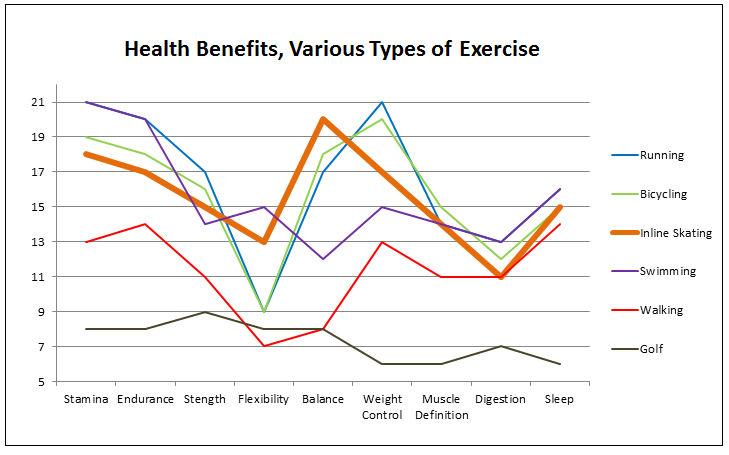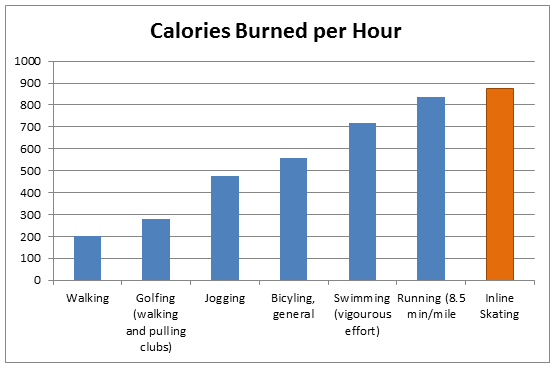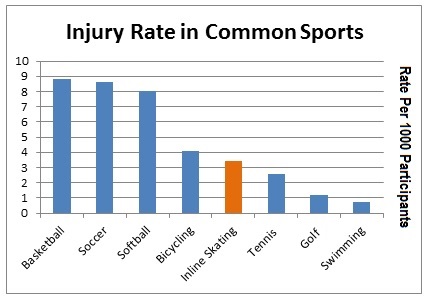5 Reason Why Inline Skating is For YOU!
5. Build Muscular Stength and Endurance:
The actions required for an Inline Skating “stride” builds muscles in your lower back, abs, hips, glutes, hamstrings, quadriceps, abductors, adductors, calves, shins, and other upper body muscle groups in the arms and back! Also, the aspects of skating that involve balance and control require several other muscles groups in the feet and ankles for an anaerobic experience with benefits of strengthening and toning. Aerobically, inline skating for 30 minutes at a steady pace raises the average heart rate to 148 bpm, almost as effective as running and more effective than cycling or stair-stepping. Does getting a full body workout get any better than this?

4. To Explore:
Inline skating allows you to span further distances than running and therefore allows a larger range for activity. Skating also gives participants a great excuse to make a short drive to check out a paved greenway on the “other” side of town. Each of these greenways have their own characteristics and some courses might fit your style more than others. Creativity and spontaneity are common feelings that overwhelm inline skaters – you will find that taking a quick detour or even finding a new route altogether comes naturally in this sport.
3. Lose or Maintain Weight:
Burning calories leads to weight loss…inline skating burns tons of these – estimated around 875 calories/hour (per calorielab.com. Make sure to use a gps program and track your skating – pay attention to pace and distance.

2. Low Impact exercise
Do your knees and ankles give you trouble? Has your doctor warned you of early arthritis? Don’t delay, skate away from these issues. A favorite benefit of inline skating is the ability to skate for hours without encountering pain or swelling afterwards. Jogging is very repetitive in nature. Your feet strike the ground over and over sending potentially harmful pressure up your legs and compression forces in your back. Some experts have proven skating to reduce the shock of running by as much as 50%. Cross-overs, double push, single push, uphill climbing, downhill drifting are just some the different “strokes” an inline skater uses. Each of these strides target different muscles groups and spread any fatigue. When did running have so many options?
1. For Fun! (Overcoming Boredom):
Inline Skating…side effects include: inability to stop smiling and general happiness! Are you burnt out of your walking/jogging regiment? Tired of those nagging running injuries? If you’re up to give inline skating a chance you will discover an exhilarating, endorphin releasing sport that is full of speed, technique, rhythm, and a love for the outdoors. I dare anyone to try the impossible: frowning with skates laced under their feet and a helmet buckled around their head.
Biggest Myth Surrounding Inline Skating…
Skating is Dangerous
False. The U.S. Consumer Product Safety Commission produced a study in 2007 which details 61,000 injuries out of 17,000,000 skaters. This data concludes an injury rate of about .35% or 3.5 injuries per 1,000 participants. Precaution must be taken and protective equipment should always be used. Helmets are mandatory to avoid brain and head injuries. At 37%, wrists are the most common form of skating injury. Wearing wrist guards can reduce these injuries by up to 87%; elbow guards can reduce elbow injuries by 82% and wearing knee pads can reduce knee injuries by 32% according to this same study. Also, performing routine maintenance and keeping all gear in proper working order helps reduce risk of injury from mechanical failure. Same goes for using only proper fitting equipment.

Join us for a Wednesday Night Skate or a Weekend Meetup Skate
